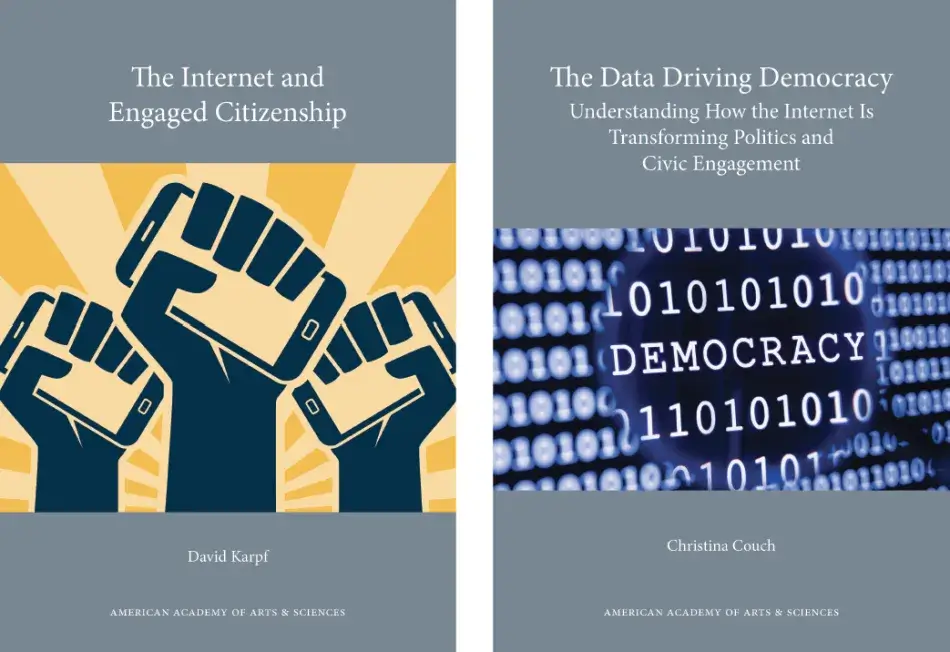Our Common Purpose
Strategy 5: Build Civic Information Architecture that Supports Common Purpose

Strategy 5: Build Civic Information Architecture that Supports Common Purpose
“You know, in the 2016 election, friendships were torn and churches were torn and never recovered as people found the political differences to be so insuperable that they could not be a community anymore. It’s like all we have left is politics. We don’t have any other form of civic community. All we have are our tribes.”
—New York, New York
The recommendations of Strategy 5 lie at the intersection of digital platforms, academic research, policy-making, jurisprudence, and economics. These recommendations are among the most technical of the Commission’s report, but the overarching idea behind them all is simple: although how people use social media and other digital platforms has negatively affected the practice of democratic citizenship, we can redesign these platforms and their uses to support, rather than erode, our constitutional democracy and sense of common purpose.
Social media and other digital platforms touch almost every aspect of our public and private lives, and they have enormous ramifications for the practice of democratic citizenship. In the public consciousness, they have done more harm than good in the past decade: feeding polarization, spreading disinformation, and diminishing the quality of public debate. But they have also helped bring new social movements into being, facilitated civic and political organizing, and given a voice to underrepresented groups. They have also led to an explosion of data about nearly every aspect of our individual lives, although it is far from sufficient when it comes to helping us understand how, when, and why Americans engage as democratic citizens outside of an election cycle. These are merely technologies that we have designed. There is no reason we cannot redesign them to support, rather than erode, constitutional democracy and common purpose.
Strategy 5 focuses on two aspects of the nation’s information infrastructure: research-relevant data sources and digital platforms (like social media and search engines). Both recommendations build on the idea that better data married with intentional design can increase transparency and accountability and can help us come up with creative and innovative solutions to democracy’s greatest challenges.
With Strategy 5, we step further away from the formal institutions of democracy and move closer to culture. Strategy 4 focused on the civil society bridges that provide the physical and often hyper-local antidotes to polarization. Strategy 5 adds a civic information architecture that supports common purpose. With Strategies 4 and 5 in place, a culture of commitment (Strategy 6) starts to come into view.

5.1
Form a high-level working group to articulate and measure social media’s civic obligations and incorporate those defined metrics in the Democratic Engagement Project, described in Recommendation 5.5.
Social media platforms are not inherently bad for democracy.
It is not hard, of course, to find examples of social media uses that weaken democratic society. Problematic practices on platforms like Facebook may impact elections, as foreign and domestic political actors sow disinformation and discord. Extremist videos on YouTube may be contributing to a wave of ethno-nationalist violence. The shooter behind the massacre at a Christchurch, New Zealand, mosque live-streamed the attack on social media and relied on it to spread his manifesto. These examples, among many others, demonstrate the undeniably negative influence of social media, and as such they have fueled reasonable calls for regulation and reform. But many other examples demonstrate how social media platforms are strengthening democratic society. In Tunisia, protesters bypassed censors and attracted international media attention by sharing footage on Facebook. The #MeToo movement has used social media to bring about change at a global level. And, of course, social media and videoconferencing technologies helped people around the world sustain a sense of connectedness during the COVID-19 crisis, helping to ensure that physical distancing did not result in utter civic isolation and atomization. There is a lesson in this: we need to work not only to prevent the detrimental impacts of social media on democracy but also to understand—and articulate a positive vision for—what social media can do for democracy.
Today’s platform developers and social media users should engage in an open and candid conversation to articulate what social media should do for us as citizens in a self-governing society. The Civic Signals project, a partnership between the National Conference on Citizenship and the Center for Media Engagement at the University of Texas at Austin, is working to facilitate this dialogue by bringing together experts to reimagine the public goods that can be generated in digital spaces. This and similar projects can support the development of metrics for evaluating the benefits or harms to democracy of social media platforms.
Metrics must be developed to understand how well a platform fulfills different areas of civic purpose: for instance, user exposure to a diversity of viewpoints. By 2026, these metrics should be in use to capture changes flowing from the following recommendations. They will help us draw distinctions between social media, generically understood, and civic media, designed for practices that are themselves supportive of democracy.
5.2
Through state and/or federal legislation, subsidize innovation to reinvent the public functions that social media have displaced: for instance, with a tax on digital advertising that could be deployed in a public media fund that would support experimental approaches to public social media platforms as well as local and regional investigative journalism.
Today, only 27 percent of Americans get their news from a local print newspaper, while 64 percent of Americans get it online.61 About 21 percent of the nation’s local papers closed between 2004 and 2018.62 Newsrooms are not the only organizations struggling to rework their business models in response to digital platforms. The nation’s local public libraries, for example, are increasingly being asked to address digital literacy, to provide local digital content, and to provide free access to computers, the Internet, Wi-Fi, and technology training.63 Our civic information architecture has been disrupted by social media, and in the case of local journalism, an important public function has been displaced.
“Most of the newspapers have gone out of business, you know? . . . Turning around and saying, ‘Oh, by the way, you know, why aren’t you an informed citizen?’ is unfair.”
—St. Paul, Minnesota
Commercial digital platforms support themselves with payments from advertisers who track our searches, our movements, even our conversations. The targeted advertising these companies engage in, and the sales they make as a result of it, should be taxed at the state and/or federal level, and the proceeds should be used to fund experiments that will teach us how to rebuild functions that support democracy.64 Experiments might take the form of civic media platforms, such as CivicLex in Lexington, Kentucky, or experiments with journalism business models, like Pro Publica’s nonprofit structure for supporting local investigative journalism in Chicago. By 2026, a tax structure in this space should be well-established, and funds should be allocated to support local journalism providers, other public-platform experiments, and growth in a new field of civic media.
5.3
To supplement experiments with public media platforms (Recommendation 5.2), establish a public-interest mandate for for-profit social media platforms. Analogous to zoning requirements, this mandate would require such for-profit digital platform companies to support the development of designated public-friendly digital spaces on their own platforms.
In Recommendation 5.2, we endorse experimenting with the creation of public media platforms and new modes for delivering local investigative journalism in order to build a field of civic media. Here, similarly, we endorse experimenting with how private social media and other online spaces might serve the public interest. The FCC’s public-interest standard was established to balance commercial interests with democratic interests, first with radio and then on television. The time has come to build on that model to establish a public-interest mandate for for-profit social media platforms.
A high-level working group should be formed to explore a public-interest mandate for private digital platforms, with the goal of passing legislation within a few years. By 2026, public-friendly spaces should be prevalent even on private social media platforms as a complement to experiments with public media platforms and civic media.

5.4
Through federal legislation and regulation, require of digital platform companies: interoperability (like railroad-track gauges), data portability, and data openness sufficient to equip researchers to measure and evaluate democratic engagement in digital contexts.
Taxes alone cannot counteract the negative impact of digital platforms on democratic engagement. Regulation will also be necessary: to require the platforms, for example, to make data available regularly, in consistent form, so that we can study how digital platforms are affecting democratic engagement. The General Data Protection Regulations passed in the EU require platforms to provide a portable copy of a user’s social media data, and major platforms are working together on the Data Transfer Project to develop an interoperability standard so data can move between service providers. A similar standard of interoperability for the syndication of social media data should be developed in the United States, along with a commitment from platforms that they will allow full usage via third-party clients.
Standards for interoperability, portability, and data openness should be established within the next few years, and public education about the importance of these topics should already be well underway.

5.5
Establish and fund the Democratic Engagement Project: a new data source and clearinghouse for research that supports social and civic infrastructure. The Project would conduct a focused, large-scale, systematic, and longitudinal study of individual and organizational democratic engagement, including the full integration of measurement and the evaluation of democratic engagement in digital contexts.
Existing data sources do not adequately capture the breadth of factors that impact democratic engagement today, especially via digital platforms. As “legacy” sources, they often center on forms of engagement that were the most common among privileged groups in society decades ago. Most do not account for the impact of state- or community-level contextual variables, and they do not have the sample size to allow municipal-level analysis. Existing large panel data sets do not generally survey individuals below the age of eighteen, and the few panel data sets that do focus on adolescents generally do not follow them into adulthood. This limits how well we can study how experiences in school and community contexts affect current or future political engagement. No current studies are specifically designed to understand democratic engagement—including both political and civic engagement—over time and the attitudes that support it during election and nonelection years.65
The Commission recommends the creation of a groundbreaking study of democratic engagement that would establish new understanding of how, when, and why people engage in democratic life. Such a study would need a collaborative source of data designed to answer big questions, which is why the Commission is recommending the creation of the Democratic Engagement Project.
In order to advance dramatically our understanding of democratic life in today’s America, the Democratic Engagement Project should: include individual- and contextual-level data; be large in sample size to ensure attention to varied racial and ethnic categories and to state- and metropolitan-area analyses; be consistent and flexible to enable comparison over time and adapt to change; be interdisciplinary by design; be open-source; be longitudinal, be repeated annually, and include a panel component; include digital and social media platform data, as described above; be accessible to local activists and civic leaders; and be attentive to adolescents.
Scholars and research experts from multiple institutions should begin project scoping and development immediately, with an eye to creating a permanent home for the Project, either at a single university or a consortium of institutions. By 2026, the Democratic Engagement Project should be providing regular data on democratic engagement at the national, state, and community levels, perhaps as a regularly released index.
